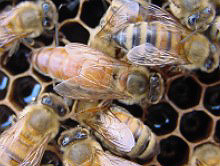<p>The queen is the largest bee in the colony. Queens are developed from larvae selected by worker bees to become sexually mature. The queen develops more fully than sexually immature workers because she is given royal jelly, a secretion from glands on the heads of young workers, for an extended time. She develops in a specially-constructed queen cell, which is larger than the cells of normal brood comb, and is oriented vertically instead of horizontally.</p>
<p>She will emerge from her cell to mate in flight with approximately 13-18 drone (male) bees. During this mating, she receives several million sperm cells, which last her entire life span (from two to five years). In each hive or colony, there is only one adult, mated queen, who is the mother of the worker bees of the hive, although there are exceptions on occasion.</p>
<p>Although the name might imply it, a queen has no control over the hive. Her sole function is to serve as the reproducer; she is an “egg laying machine.” A good queen of quality stock, well reared with good nutrition and well mated, can lay up to 3,000 eggs per day during the spring build-up and live for two or more years. She lays her own weight in eggs every couple of hours and is continuously surrounded by young worker attendants, who meet her every need, such as feeding and cleaning.</p>
<p>[From The National Honey Board – www.honey.com]</p>

